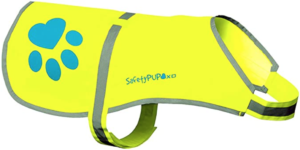We all know that our dogs need daily exercise, and most dogs love to run and play. From a simple walk or playing with a ball through to trail running and agility classes, the variety of exercise opportunities for our dogs is endless. But what type of exercise is best for your dog?

Exercise is important not just for physical fitness but also for mental stimulation. Let’s take a good look at our dog’s exercise needs and discover some fun ways to exercise with your dog!
Basic exercise needs
The exercise needs of dogs vary greatly according to age, breed, body weight, and even personality. Some breeds, such as French Bulldogs and Greyhounds, do not require high amounts of exercise, preferring short high-intensity bursts of play followed by long periods of rest. Other breeds need high levels of exercise and stimulation, such as Border Collies and Labrador Retrievers.
You are the best person to figure out what your dog needs and if he is getting enough exercise. Is he keen and excited to go out, or not overly interested? Do you get the feeling he could go twice as far as you manage to take him on your daily walk, or is he all burnt out by the time you get home? Maybe he seems a bit bored on your daily walk around the block, but bounces with excitement at the prospect of a play in the park?
If you find you don’t have time to give your dog enough exercise then there are other ways to provide this, such as hiring a dog walker for the days you don’t have time. You could also pair up with a local dog buddy, so you can help each other out with dog walking. The added bonus to this is that your dog gets a playdate as well!
It is good to mix up your dog’s exercise routine so they don’t get bored. Mixing in playtime and training into the day as well as a walk will help to keep their brains active as well as maintaining physical fitness. Time spent outside the house off the lead, either in a garden, park, or secure play area, will allow your dog to have a run and explore.
Walking your dog
Unfortunately, many of us are in areas where it is difficult to let our dogs run off the leash. Walking on the leash may be the only exercise opportunity our dogs get, but this does not mean that it has to be dull or boring. We can make walking our dogs mentally stimulating as well as providing a means for exercise.
Vary the route as much as possible; even something as simple as reversing your route each day can make it more interesting for your dog; and allow your dog the opportunity to sniff and explore when you can. Try including some training exercises in your walk such as sit, stay, and recall, to provide some emotional stimulation as well as physical exercise.
Play sessions
It is common now to see people exercising their dogs by throwing a ball or Frisbee in the park or garden rather than going for a walk. This can be a quick and easy way for your dog to let off some energy, but is it fulfilling your dog’s emotional needs as well?

View on Amazon
Play sessions can be a great way to get you and your dog moving and provide some mental stimulation. Avoid repetitive exercises such as prolonged ball throwing and mix the exercises up a bit. Play sessions are also a great opportunity to work on training your dog, such as sit-stay and recall exercises.
You may find that your dog has a hidden talent for play-based activities. If this is the case then why not give agility a try? Agility classes are a fun and exciting way to exercise with your dog.
Indoor exercise
You may live in a city apartment or not have easy access to long walks or parks, but there are fun ways you can exercise your dog inside as well. If you have a floor space free from hazards then encourage your dog to play and exercise indoors, giving them mental as well as physical stimulation.
Making an indoor obstacle course is a great way to exercise your dog indoors. Obstacles can include poles to step or jump over, objects to weave around, and even a ‘tightrope’ style walkway.

View on Amazon
Playing fetch indoors can be a fun way to exercise your dog. Try hiding your dog’s favorite toys or a treat ball and see how long it takes them to find it. If you have stairs in your home, use these to increase your dog’s physical exercise by playing fetch or recall games up and down them.
Training for fitness
Some dogs just love to run, so why not take your canine friend on your daily training exercise? Running with your dog can be physically and emotionally rewarding for you both, providing your dog with the feeling of running with his ‘pack’. As with your own fitness training, build up your dog’s exercise levels gradually to avoid training injuries.
Start by finding a safe route for you both and walk it a few times before beginning to run. Avoid routes with a lot of traffic, pedestrians, and cyclists if possible. Remember to make sure you are both visible – there are some great high-viz dog accessories available!

View on Amazon
Once you’ve picked your route then start to incorporate some steady jogs into your walk. Gradually increase the speed and length of your jogs until you get to a pace you are both comfortable with. Take water for both of you and make sure your dog gets a rest if he appears tired or panting.
Reducing obesity
It is no secret that our dog population is getting fatter, with over 55% of dogs in the USA now classed as overweight or obese. As with humans, there are many ‘miracle cures’ for weight loss in dogs, but the simplest way is to make sure your dog uses more calories than he consumes each day. So, firstly have a look at your dog’s daily diet, then think about how to increase his exercise levels.
Overweight or obese dogs are more at risk of musculoskeletal injuries or disorders of the cardiac and respiratory systems. Therefore, it is important to build up exercise levels slowly and gradually. Walking and gentle runs will burn a surprising amount of calories, and you can make these longer and more energetic as your dog starts to lose weight.
Once your dog’s fitness levels improve, increase the intensity of the exercise by introducing different types of exercise. A great way to do this is by playing with a frisbee or ball, or starting short sprints on your daily walks.

View on Amazon
Exercising young dogs
There is nothing quite as lively and energetic as a puppy! Juvenile dogs are a bundle of energy who will run and play for hours. A bored puppy who does not receive enough exercise and stimulation will quickly develop behavioral problems such as chewing or barking.
Young dogs can develop musculoskeletal disorders if exercised incorrectly during growth periods. Exercises that involve putting a lot of strain on their legs, such as jumping or running up and down the stairs, are not advisable for a developing puppy. Avoid intensive exercise such as long periods of running or long-throw fetch exercises.
The amount of exercise a puppy requires depends on its age, breed, and size. As a rough guide, aim to exercise your puppy for five minutes per month of age, twice a day:
- 3 months old – 15 minutes exercise twice daily
- 4 months old – 20 minutes exercise twice daily
- 5 months old – 25 minutes exercise twice daily
- And so on, until your puppy reaches physical maturity
This amount can be increased or reduced depending on how your puppy responds. Young dogs tire easily and need time to rest and recover after exercise.
This cautious approach to exercise must be continued until your puppy reaches physical maturity. The age when this occurs varies depending on the breed of dog. Small breeds generally reach their adult height at 12 months of age, while large breeds may take up to twice as long.
Exercising elderly dogs
As dogs begin to age their exercise requirements change. Your dog may have always enjoyed two long walks every day, but you might notice they are not so keen to go out anymore. It is important not to stop exercising your elderly dog, but instead alter your exercise routine to keep them mobile and active.
Elderly dogs will benefit from regular and gentle exercise to keep their muscles and joints supple. They still need mental stimulation, so make sure they get the opportunity to get out and explore every day. Elderly dogs may struggle in bad weather so bear this in mind when planning your exercise.
As dogs become older, their senses such as sight and hearing may start to deteriorate. Exercising in familiar areas and sticking to the same routes can help prevent your elderly dog from becoming anxious or confused.
Our dogs may be confined to the house for many hours each day and daily exercise can be the highlight of their day. Put yourself in your dog’s shoes (or paws!) and see what changes you could make to his exercise routine.







